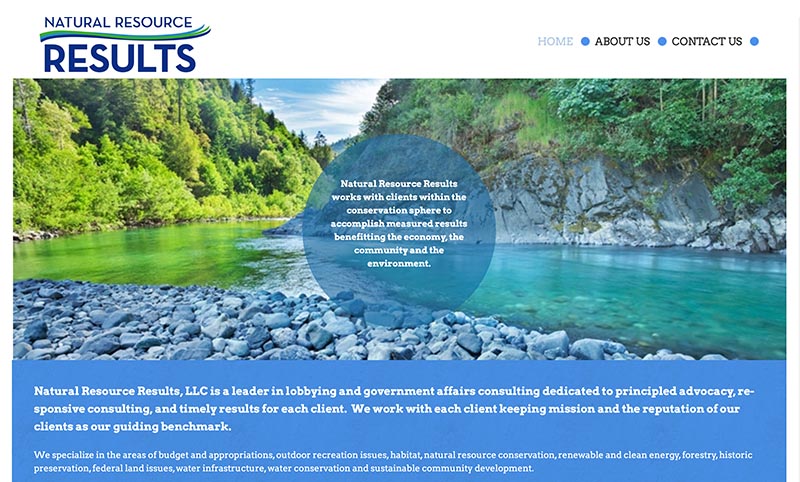
Advocacy & Consulting
Ambitious conservation for
business, passion, or both.
Advocacy & Consulting
Ambitious conservation for business, passion, or both.
wa-ter-shed (wo’tər-shĕd’)
1. The gathering ground of a river, stream, or lake.
2. A moment or event marking a significant change.
Ambitious conservation for business, passion, or both.
Watershed Results solves problems and captures opportunities in the balance of business and nature and in the progress of stewardship missions
What We Do
Issues
Every business and passion moves in a traffic of problems and opportunities. Your time, talent, and treasure must be geared to turn effort into active solutions and progress.
- Lobbying to change or create new policy. Meeting, engaging, and negotiating with decision-makers in agencies and committees takes dedicated time and effort.
- Project management. Assembling the people and resources to do something is as big a task as moving an issue through government.
- Philanthropy and Investment. Many people are pursuing conservation in in many ways. Watershed Results helps you connect with effective partners for you and your passion.
Voice
To have your say, someone must be listening. The message, the platform, and the volume all must be right – because communication is not just a message sent, but one that is also received.
- Earned media. We engage with publishers, editors, and reporters to deliver your voice in print, broadcast, and digital media.
- Negotiation. We do this everyday in the course of all we do, but big negotiations are stand alone projects.
Relationships
People are the basic ingredient of every goal and objective. Watershed Results helps you meet and engage the people who are or must be involved in what you are doing.
- Alliances. When you need a bigger team.
- Roundtables. When you need more people at the drawing board.
Call me and let’s do something about your issues!
The first move you make is always a big step forward.
After that, it’s just a few strides to get up and running.
Areas of Experience and Expertise
Budget and Spending
Federal and state budgets are the “bigger half” of policy along with laws and rules. Laws and rules change occasionally; budgets set levels of effort every year (or 2, in some states).
WR has directed funds to research on wildlife diseases, solutions to conflict between wildlife and livestock, smart fixes for Threatened and Endangered Species, and attention to Federal lands.
Several clients are powering their advocacy with cost-sharing and market structures for government that position them as responsible and respectful of the limits on public spending to be all things to all people.
Litigation
Lawsuits are nearly routine in conservation because, despite voluminous laws and regulations as guides, many decisions come down to the professional judgment of the agencies. Consensus on these choices is rare and possibilities abound for errors on technicalities in the decision-making process.
The considerations here are powerful: access to the courts, paralysis of process, and the stakes for harm to people or nature on either side of the questions. US policy since the mid-1900s has been to invite citizen lawsuits as part of the transparency of public decision-making. It has also been US policy to reimburse the legal fees of plaintiffs who sue the government and win.
WR is not a law firm but works on the issue of litigation, focusing on the Equal Access to Justice Act and citizen-suit provisions of conservation laws. The enactment of the Open Book on Equal Access to Justice Act in 2019 makes data on litigation available that will help determine why lawsuits are filed and what they cost. This will inform a better understanding of the role litigation plays in conservation.
Private Lands
Private lands are – all together – an enormous and valuable estate in conservation. Private land – to the landowner – is home or an investment. There are many opportunities for the public to benefit from private-land stewardship and many problems in successfully protecting landowner rights at the same time.
One of the most common ways to gain the opportunities and solve the problems is through a conservation easement. This is essentially a contract that transfers some rights of the landowner to a public-interest entity such as a government agency or a public charity. The deal is recorded on the deed to the land so it continues in perpetuity as the land changes owners. Another means of sharing the public and private interests is through a term contract that pays the landowner to provide a public service of conservation such as by fallowing a farm field or improving habitat, wetlands, or waterbodies on the land.
Conservation easements are governed by the tax code for charitable giving (for easements donated to charities) and by conservation programs that pay landowners (for purchased easements). Several public programs and some private investors are paying landowners for contracts
Public Lands
“The Land of Many Uses” is the motto of the National Forests and might as well be for most Federal public lands. There is a lot of opportunity on these lands, but the possibilities cannot all be available in all the same places. Often, this is a problem.
Many issues on public lands are about where the drilling, hunting, biking, timber harvesting, paddling, wind farming, etc. should be allowed. After that gets decided, more issues follow on how each thing should be done.
Laws and regulations guiding (and complicating) the issues began going on the books in the late 1800s and have been accumulating ever since. Also, Congress still holds authority for designating areas for special uses such as Wilderness.
Water
It is necessary for life, it gets in the way of life, and – in a flood – it can take your life. And it is the source of many issues concerning quantity, quality, and the location and care of wetlands.
The US has been struggling for decades with an unresolved policy on how far Federal jurisdiction follows water from navigable waterbodies at the bottom of a watershed up through the tributaries, lakes, and ponds where it gathers. Our country is still also figuring out irrigation, flood control, and how to replace water sources in desert habitats where natural water has been diverted from wildlife use for human use.
Because water has something to do with everything, nearly every governmental agency has something to do with water. The EPA governs quality and wetlands. The Corps of Engineers shares wetland jurisdiction and manages dams for flood control and navigation. The Farm Bill deals with water in several ways. The Bureau of Reclamation administers irrigation works. Federal land agencies such as the Forest Service, Bureau of Land Management, and Fish and Wildlife Service are stewards of Federal water rights. The state’s govern other water rights.
Wildlife Agencies
Professional wildlife biologists and other specialists are the [rank and file] of everyday American conservation. By 1933 when the first wildlife management textbook was published, every state in the country had a wildlife agency. Soon after, The Wildlife Society was formed as the professional society of wildlife biologists.
Every state agency operates on money raised by selling hunting and fishing licenses and by taking an allocation of Federal taxes on hunting weapons and ammunition and motorboat fuel. These programs have focused on huntable and fishable fish and wildlife. The needs and challenges of managing other wildlife and better engaging the general public have stretched the work.
The principle behind the original funding and game laws is now considered in the debate for new law in this arena. User-pay/Public-benefits.
Wildlife Law and Regulation
The restoration of fish and wildlife in North America from many near-extinctions in the 1800s is an amazing accomplishment. It is marred by extinctions that did happen, and the story is still being written for species in trouble today.
For the successfully-restored species such as deer and elk, there is still work to do to manage habitat, and population size (to increase or decrease), and disease. Restoration is still in progress for others such as wild sheep. Fisheries issues are complicated by extensive relocations and introductions of species across the country and the resulting joys of good fishing and perils of invasive species and hybridization. There is a long list of fish and wildlife species designated as Threatened or Endangered.
The principal policies for fish and wildlife are in state law. Federal policies either share or supersede state jurisdiction such as the Migratory Bird Treaty Act and the Endangered Species Act. Marine mammals have their own federal law. Under the Property Clause of the Constitution, Federal public land policy extends some power over wildlife too, such as on National Wildlife Refuges.
Conservation Innovations
Traditional conservation in America is made of law and regulation, public spending, and attracting volunteers for work and advocacy. Many people, groups, and businesses engage in one or more of these [ways]. More recently, new approaches have developed that rely on contracts and other agreements, private investment and transactions, and the delivery of conservation to people in their everyday lives instead of recruiting them into conservation.
The difference is creating more success for wildlife, fish, water, and land. Landowners today can make money by creating habitat, which multiplies the benefits of regulations that limit the loss of habitat. By working together on a common conservation plan, neighboring landowners can create an equal or better benefit than a public-land refuge or park. Corporations are creating their own conservation programs for their employees while on the job and on the land owned by the business.
WR is a proud partner with innovators of these approaches: PERC , Sand County Foundation, and Texan By Nature.
Conservation Leadership
Conservation is driven by people, and people working on this need the same expertise and professionalism as required in any endeavor. Beginning from their roots among professional foresters and ecologists, conservation professionals established disciplines of science in the management of wildlife, fish, soil, and grasses. As professional agencies and advocacy groups were established, experts entered the administrative and legal positions necessary to run these operations.
The leaders of conservation today represent the third and fourth generations of the founders of this ethic in America. We face the same struggles of job turnover and succession that all professions must reckon with. The necessary skills have expanded from technical proficiency in ecological disciplines to staff management, administration, and negotiation.
WR supports the development of new conservation leaders and the improved collaboration among current leaders through the National Conservation Leadership Institute, Boone and Crockett Club University Programs, and the Conservation Roundtable.
Sportsmen Conservation
Hunters and anglers have played many roles in American history. Today they drive the ethic, advocacy, and economy of wildlife conservation. In pursuing meat for the table and the experience of seeking and sustaining wildlife, they pay for and do most of the work.
The ethic of Fair Chase is a personal creed of restraint and respect shared by committed sportsmen. Sportsmen organizations now exist for nearly every game species and habitat. Working together as the American Wildlife Conservation Partners, these groups advocate for the laws, budgets, and programs that compose the modern conservation movement. Through license fees, self-imposed taxes, and the cost of trips, sportsmen dollars circulate to professional agencies, local communities, and landowners that care for and support wildlife populations.
WR proudly partners with the Congressional Sportsmen’s Foundation in this work in Washington and the state capitols
How We Do It
Teamwork
Personal attention to clearly defined tasks and regular teamwork with you to engage the right people, apply ideas and leverage, and repeat until done.
About Greg
Call me and let’s do something about your issues. The first move you make is always a big step forward. After that, it’s just a few strides to get up and running.

(202) 657-4330




